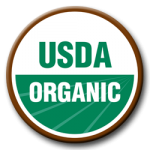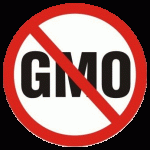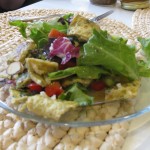Note to reader: this is part of a 5 week series I am presenting at Gilda’s Club Westchester. I thought everyone could benefit from this information so I’m sharing it here.
Knowing Your Ingredients is key to healthy eating. It can be overwhelming to those of you new to this. So lets start with some definitions so we all know what we’re talking about
 Organic is a term defined by the USDA. You can get into big trouble saying something is USDA certified organic if it is not.
Organic is a term defined by the USDA. You can get into big trouble saying something is USDA certified organic if it is not.
Organic food is defined as grown without synthetic pesticides and chemical fertilizers. No GMOs, (genetically modified organisms), no irradiation, industrial solvents or chemical food additives are permitted in organic food
Note: that some farmers at farmers markets are not USDA organic certified but they use organic methods in growing their food. Its very expensive to get certified, many small farmers cannot afford to do so.
Natural is a widely used term in food labeling and marketing. The term is assumed to imply foods that are minimally processed and do not contain manufactured ingredients, but due to the lack of standards, the word natural means basically nothing. Do not get sucked into believing that a product is good for you because the word natural is used!
 GMOs – genetically modified organisms- are defined as an organism whose genetic material has been altered by means of genetic engineering. The problems with GMO ingredients are that there are no long term studies proving they are safe. It gets even creepier from there. Here are links where you can find more info. 80-90% of all corn and soy in the US is GMO, your best bet is to choose organic corn or soy. Click here to learn more about the problems with GMO
GMOs – genetically modified organisms- are defined as an organism whose genetic material has been altered by means of genetic engineering. The problems with GMO ingredients are that there are no long term studies proving they are safe. It gets even creepier from there. Here are links where you can find more info. 80-90% of all corn and soy in the US is GMO, your best bet is to choose organic corn or soy. Click here to learn more about the problems with GMO
The Dirty Dozen and the Clean 15 are useful downloadable shopping resources offered by the Environmental Working Group. you can download a PDF for your wallet or even an app for your smart phone. Click here for more info. The Dirty Dozen are the 12 fruits and veggies with the highest pesticide content- those 12 fruits and veggies you will definitely want to invest in organic over conventional. The Clean 15 are the ones with the least amount of pesticide residues, those you can save money and buy conventionally. By the way, “conventional” produce is grown conventionally: with petrochemical fertilizers and pesticides. Its the opposite of organic.
3 “shoulds” for food. I have always had these little “food rules” under my belt as part of my food philosophy. I strongly recommend that you take some time to come up with your own personal food rules
1. Food should have pronounceable ingredients. You should not need a degree in chemistry to be able to read the ingredient list!
 2. Food items should be recognizable by previous generations: Your parents and your grandparents didn’t have insane items like Vitamin Water and neon pink yogurt in a tube.
2. Food items should be recognizable by previous generations: Your parents and your grandparents didn’t have insane items like Vitamin Water and neon pink yogurt in a tube.
3. Food should not have a massive PR /advertising budget. Chances are its not food but some edible foodlike substance. this is true for our parents generation too, remember Tang? That wasn’t a real food, it was a chemical powder that astronauts took with them on trips to space! Remember, if it sounds too good to be true it probably is!
To read more food rules, check out Michael Pollan’s book, Food Rules
Here’s something that Michael Pollan forgot to include in his many books:
SuRu’s Top 5 toxic ingredients to avoid
#5 Artificial sweeteners- are of no benefit. These chemicals may taste sweet with no calories, but they co-opt your taste buds, causing you to crave artificially sweet ingredients. That’s how people become addicted to diet soda and gum. Some have been shown to have neurotoxic properties and have other health risks.
#4 Hydrogenated anything! This is the technical term for “trans fats”. Our government was under pressure from the food industry, so they made a loophole. Some labels can say “zero trans fats” per serving when its not. Just look for the word “hydrogenated oil” in the ingredient list, and put it back on the shelf. Don’t allow this crap in your home.
#3 HFCS- high fructose corn syrup or “corn sugar” or whatever the corn industry wants to call it. This ingredient is not found in nature, is manufactured with GMO corn most of the time.The food industry loves this ingredient because it makes you not feel full so you will eat and drink more. Large amounts of fructose in the absence of fiber raises your triglycerides/ LDL cholesterol.
#2 Soy– this ingredient was never intended for human consumption. It was grown between food crops to replenish nitrogen in the soil, then tilled under. Asian cultures didn’t eat it until they learned to ferment it into things like miso, tempeh and soy sauce. Here in the US, it is our #2 crop, we feed it to animals (not a good idea) and more than 80% of it is GMO (an even worse idea). Stay far far away from things like soy protein isolate, soy powders and “bars” containing anything with the word soy. Miso, edamame, tempeh and soy sauces are ok, just make sure they are organic.
and…….drumroll please……
the absolute top #1 toxic ingredient
the one ingredient to avoid at all costs
is
are you ready for it?
 #1 COTTON! Cotton is not a food, never was, never will be. Cotton is the world’s most toxic crop. 25% of all the insecticide in the world is sprayed on cotton crops, polluting water, soil and air and endangering the health of those who live nearby. These poisons are not approved for human consumption because cotton is a fiber crop, not a food crop. Cotton ends up in our systems in the form of cottonseed oil which is used widely in processed foods, and as cottonseed feed for cows, ending up in meat and dairy products. The pesticide residues from these cottonseeds concentrate in the fatty tissues of these animals, and in turn are passed on in meat and dairy products to us, the uninformed eater.
#1 COTTON! Cotton is not a food, never was, never will be. Cotton is the world’s most toxic crop. 25% of all the insecticide in the world is sprayed on cotton crops, polluting water, soil and air and endangering the health of those who live nearby. These poisons are not approved for human consumption because cotton is a fiber crop, not a food crop. Cotton ends up in our systems in the form of cottonseed oil which is used widely in processed foods, and as cottonseed feed for cows, ending up in meat and dairy products. The pesticide residues from these cottonseeds concentrate in the fatty tissues of these animals, and in turn are passed on in meat and dairy products to us, the uninformed eater.
In addition to the highly toxic pesticide residues, the inflammatory nature of cottonseed oil is really tremendous. The ratio of Omega 6 to Omega 3 is of the order of 259:1. If you have been supplementing with Omega 3 oils or flaxseed to help with inflammatory health issues, just one little Girl Scout cookie containing a small amount cottonseed oil will undo all the good work you’ve been doing. Yes, it is that toxic. Its also super duper cheap which is why the food industry loves it.
The bottom line is never ever eat food containing cottonseed oil. To learn more about this most toxic of ingredients, visit one of my blog posts from the past: Cotton is Not a Food.
 Note: in addition to the Ingredients class, Gilda’s participants got to enjoy a Japanese Omelette Salad and a Curried Butternut Squash Soup, proving that real ingredients can be good for you and so, so so delicious.
Note: in addition to the Ingredients class, Gilda’s participants got to enjoy a Japanese Omelette Salad and a Curried Butternut Squash Soup, proving that real ingredients can be good for you and so, so so delicious.


